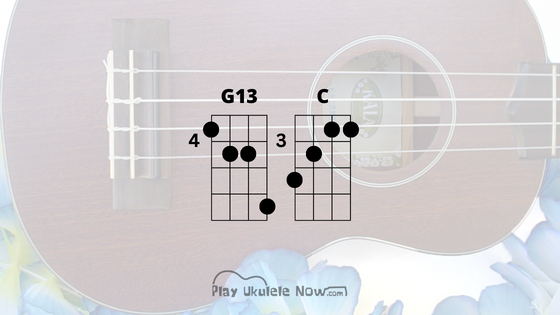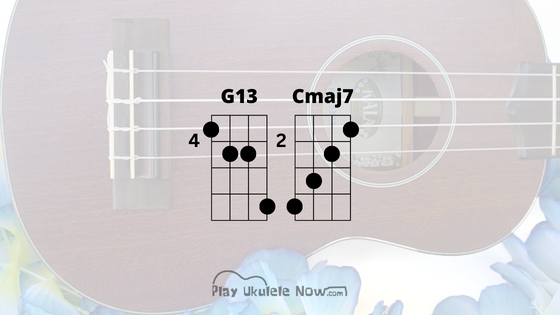You have to try these!
You will Learn More and Play More with Play Ukulele NOW.
Find out for yourself why teachers and students have depended on Play Ukulele NOW Methods and Songbooks since 2009
Find out for yourself why teachers and students have depended on Play Ukulele NOW Methods and Songbooks since 2009
DISCLOSURE: THIS POST MAY CONTAIN AFFILIATE LINKS, MEANING I GET A COMMISSION IF YOU DECIDE TO MAKE A PURCHASE THROUGH MY LINKS, AT NO COST TO YOU. PLEASE READ MY DISCLOSURE FOR MORE INFO.
Embellishments for the ii (iii, or vi) chord are:
Chord book and all scales harmonized with chords:
Do me a favor and 'like' the video on YouTube and post a comment (on YouTube) to let me know what you think - thanks!
Find all my chord related posts here: Chord Tips and Tricks
Previously we've talked about the following:
Embellishments for the I (or IV) chord are:
- 6 (major 6 chord) - Happy and relaxing - Used for endings
- Major 9 - Relaxing and restful
- 6/9 (major chord) - Warm, sweet and mellow
- Major 9 #11 - Floating, pleasing, slightly unresolved
Embellishments for the ii (iii, or vi) chord are:
- Minor 7b5 - Enchanting and beautifully balanced (half diminished chord but not used here as one)
- Minor 9 - slightly dissonant, but bluesy and sophisticated sound
- Minor 11 - sophisticated, soulful 'rainy day' sound
(Dominant only) Embellishments for the V (a dominant chord may be subbed for any chord):
- Dominant 9 - An exciting feeling of movement
- Dominant 13 (this lesson)
This is the continuation of my "Ukulele Chords and How to Use Them" Series, in this lesson we look at the dominant 13.
Any Dominant (or altered dominant*) can be subbed for the V chord (or any other chord); as we've learned previously - any chord can be a dominant. And we've seen this in action in a blues progression as well.
In many blues progressions all the chords are dominant 7's - but they could be any dominant chord or any combination dominants (9's; 13's) and other chords.
Can all the chords be 13's in a blues progression? Yes they can...
Most commonly we'll find the dominant 13 as a sub (or embellishment) for the V chord...
The two most common dominant subs for the V chord are the dominant 9 and the dominant 13, the other popular subs would be altered dominant chords...
*Altered dominants can't be used for the I chord unless you play an unaltered V7 first (unless your name is Jimi Hendrix or SRV - then you may use a dominant 7#9 for the I chord in as many songs as you like). Remember: There are exceptions to every rule.
Check out the dominant 13
Check out how the dominant 13 sounds as the V chord resolving to the I
Here is is resolving to a regular old C chord - strum each chord slowly and listen...
Here is is resolving to a C major 7...
About the Dominant 13
The dominant 13 consists of 7 tones; the root note (1); a major third (3); a perfect fifth (5); a minor 7 (b7); the 9th tone (9); the 11th tone (11) and the 13th tone (13).
Even on the guitar - 13 chords are typically played as 4 note chords, there are 2 common configurations: They either have the 3rd; the 7th; the 9th and the 13th, or the root note; the 3rd; the 7th and the 13th.
These are similar forms to what a guitar player may use.
To make the dominant 13 we take a dominant 9 chord and raise the 5th 1 step (two frets). We then get the 6th which is the 13th.
Dominant chords are written (for the chord symbol) without the word 'dominant' like so: C13 or G13. Major or minor 9's always include the words 'major' or 'minor.'
Here are a few popular and very usable forms:
With the 2nd and 3rd forms - you can easily play the root note rather the the 9th for a different spelling of the chord (1 (root); 3; 7; 13). So you'll have 6 different chords here. NOTE: For the second chord form, I raised the 5th of the dominant 9 (to get the 6th) and rearranged the notes (notes on strings 1 and 4 were swapped) a little bit as well to create a more usable form...
Let's look at some progressions
PROGRESSION 1: We'll look at it as an ending first - here's one of my favorite endings using the dominant 13.
PROGRESSION 2: Here's another nice ending - we use a 9 for the passing chord rather than the 13b9:
You can use the major 7 above for the I chord instead of the regular C chord if you like in either one of these.
PROGRESSION 3: Here we have a basic ii - V - I with a 13 for the V. It could resolve to the 6/9 like so: Dm9 - G13 - C6/9; but to add some interest I alter the I chord like so: Dm9 - G13 - Cmaj9 - C6/9 (all the chords here link to the lessons for those chords)
PROGRESSION 4: Here we alter the V chord in another ii - V - I (this ones a little higher up on the neck so we can get some nicer chord forms).
I like this dominant 13 form because the 13th is on the 1st string and I like this major 7 form because the 7th is on the 1st string and because it sounds nicer to me than the open form.
My least favorite 13 form is the one in the previous progression - but it could come in handy if you need to be in that position for a chord melody arrangement:
PROGRESSION 5: Here it is without the altered chord - just a standard ii - V - I:
With all of these progressions, you can use embellishments we discussed in prior lessons for the I and the ii chord.
Now go and create some beautiful chord progressions...
Start by using these as the V chord and remember any chord can be a dominant so you can use them anywhere you like... Could a blues progression be all dominant 13's? Yes - it could.
To learn how to create beautiful chord progressions in any key get my "Secrets of the Chord Chain" books.
RELATED VIDEO
In this video we look at the rule 'Any chord can be a dominant'
Do me a favor and 'like' the video on YouTube and post a comment (on YouTube) to let me know what you think - thanks!








.png)
.png)








No comments:
Post a Comment